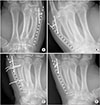Abstract
Purpose
Methods
Results
Figures and Tables
 | Fig. 1Fracture angulation was analysed using uninjured contralateral metacarpal (A), injured metacarpal preoperative (B), postoperative (C), and long term follow-up (D) X-ray images. Measurements have been undergone on oblique views of hand X-ray. Measured values were utilized for intergroup comparison, and besides difference of angles were figured out (i.e., b-a, c-a, and d-a) to avoid normal angulation between metacarpal head and shaft. |
 | Fig. 2Case 1. (A) A 28-year-old male patient was injured on the right 5th metacarpal bone, angulation 48°. (B) The metacarpal neck fracture was reduced using closed reduction and parallel transverse pinning method, showing 20° angulation. (C) However, heavy functional activities have led to slight recurrence (angulation 23°) at 4 week postoperative period. |
 | Fig. 3Case 2. (A) A 30-year-old male patient was injured on the right 5th metacarpal bone, angulation 39°. (B) The metacarpal shaft fracture was reduced using open reduction and internal plate fixation method, showing 17° angulation. (C) Active exercise was followed by implant removal at 30 weeks postoperatively. The metacarpal shaft presented stability with maintenance of 15° angulation. |
 | Fig. 4Fracture angles were analysed based on the difference between angulation of injured and uninjured metacarpals. Group 1 and 2 showed adequate reduction postoperatively. However, Group 1 (closed reduction and percutaneous parallel pinning) demonstrated slight recurrence in terms of angulation (p<0.05). Nonetheless, Group 2 (open reduction and plate internal fixation) presented consistent maintenance of reduction state. PreOp: Preoperation, PostOp: Postoperation. |
Table 1
Patient demographics: inter-group analysis did not show significant differences for number of patients, sex, age, observation period, or fracture site

Table 2
Angulation analysis in Group 1

Values are presented as mean±standard deviation. Angulation at preoperative and follow-up periods exhibited significant difference, in comparison with the average of normal side. Nonetheless, measurements at immediate postoperative state demonstrated comparable outcomes between fractured and uninjured metacarpals.
Group 1: closed reduction and percutaneous parallel pinning.
*p<0.05.
Table 3
Angulation analysis in Group 2

Values are presented as mean±standard deviation. Angulation at preoperative period exhibited significant difference, in comparison with the average of normal side. Nonetheless, postoperative and follow-up measurements showed comparable outcomes, when compared to the normal side.
Group 2: open reduction and plate internal fixation.
*p<0.05.




 PDF
PDF ePub
ePub Citation
Citation Print
Print


 XML Download
XML Download